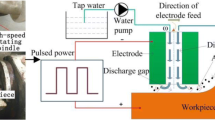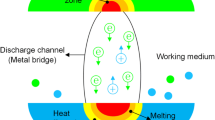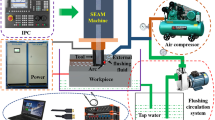Abstract
The objective of this present work is to find out the optimum level and influence of short electric arc milling (SEAM) process on material removal rate (MRR), relative tool wear ratio (RTWR) and deformation layer thickness (DLT). The mathematical model of the interaction of influencing factors was established by using the design expert software. The optimal level of input parameters such as voltage, pulse frequency, duty cycle, pressure of working medium is calculated by response surface center composite method to achieve maximum MRR and minimum RTWR and DLT. It is found that the effective discharge energy matches the hydrodynamic arc breaking mechanism, which can better control the MRR and RTWR. Similarly, the experimental results show that under the conditions of 32 V voltage, 70% duty cycle, 0.6 kHz pulse frequency and 0.4 MPa working medium pressure, the MRR of aviation aluminum alloy reaches 16,733 mm3/min and RTWR is limited to 1.549%. The obtained data can be utilized for the SEAM industry during the high efficiency machining of aluminum alloy.








Similar content being viewed by others
Availability of Data and Materials
All data generated or analyzed during this study are included in this published article.
References
M. Curioni, P. Skeldon, G.E. Thompson and J. Ferguson, Graded Anodic Film Morphologies for Sustainable Exploitation of Aluminium Alloys in Aerospace, Adv. Mater. Res., 2008, 723, p 524.
M. Subramanian, M. Sakthivel, K. Sooryaprakash and R. Sudhakaran, Optimization of End Mill Tool Geometry Parameters for Al7075-T6 Machining Operations Based on Vibration Amplitude by Response Surface Methodology, Measurement, 2013, 46(10), p 4005–4022.
M. Casuso, R. Polvorosa, F. Veiga et al., Residual Stress and Distortion Modeling on Aeronautical Aluminum Alloy Parts for Machining Sequence Optimization, Int. J. Adv. Manuf. Technol., 2020, 110, p 1219–1232.
L. Wang, F. Qiao, Y. Li et al., Optimization of Clamping for Thin-Walled Rotational Conical Aluminum Alloy with Large Diameter: Modal Simulation and Experimental Verification, Int. J. Adv. Manuf. Technol., 2021, 114, p 2387–2396.
A. Madariaga, I. Perez, P.J. Arrazola et al., Reduction of Distortions in Large Aluminium Parts by Controlling Machining-Induced Residual Stresses, Int. J. Adv. Manuf. Technol., 2018, 97, p 967–978.
M.C. Santos, A.R. Machado, M.A.S. Barrozo et al., Multi-objective Optimization of Cutting Conditions When Turning Aluminum Alloys (1350-O and 7075–T6 Grades) Using Genetic Algorithm, Int. J. Adv. Manuf. Technol., 2015, 76, p 1123–1138.
S. Li, B. Zou, K. Xu et al., Machined Channel Quality and Tool Life Using Cermet Micro-Mill in Micro-Milling Aluminum Alloy, Int. J. Adv. Manuf. Technol., 2019, 101, p 2205–2216.
S.V. Alagarsamy, P. Raveendran and M. Ravichandran, Investigation of Material Removal Rate and Tool Wear Rate in Spark Erosion Machining of Al-Fe-Si Alloy Composite Using Taguchi Coupled TOPSIS Approach, SILICON, 2021, 13, p 2529–2543.
A.P. Markopoulos, E.L. Papazoglou, P. Svarnias and P. Karmiris-Obratański, An Experimental Investigation of Machining Aluminum Alloy Al5052 with EDM, Procedia Manuf., 2019, 41, p 787–794.
P.S. Rao, K. Ramji and B. Satyanarayana, Effect of Wire EDM Conditions on Generation of Residual Stresses in Machining of Aluminum 2014 T6 Alloy, Alex. Eng. J., 2016, 55, p 1077–1084.
N. Kravchenko and M. Kliuev, Novel Method of Multi-axis EDM Machining of Thin-Walled Al-Mn Parabolic Reflector for Aerospace Applications, Procedia CIRP, 2022, 113, p 64–69.
M. Anand and A.K. Das, Grain Refinement in Wire-Arc Additive Manufactured Inconel 82 Alloy Through Controlled Heat Input, J. Alloys Compd., 2022, 929, p 166949. https://doi.org/10.1016/j.jallcom.2022.166949
J.P. Zhou, C.H. Liang, W.J. Teng, Y. Xu and B.S. Zhou, Study on Rules in Material Removal Rate and surface Quality of Short Electric Arc Machining Process, Adv. Mater., 2008, 33–37, p 1313–1318.
A. Ramaswamy and A.V. Perumal, Multi-objective Optimization of drilling EDM Process Parameters of LM13 Al Alloy–10ZrB2–5TiC Hybrid Composite Using RSM, J. Braz. Soc. Mech. Sci. Eng., 2020, 42(8), p 1–18.
S. Marichamy, B. Stalin and M. Ravichandran, Optimization of Machining Parameters of EDM for α-β Brass Using Response Surface Methodology, Mater. Today Proc., 2020, 24, p 1400–1409.
M. Anand and A.K. Das, Issues in Fabrication of 3D Components Through DMLS Technique: A review, Opt. Laser Technol., 2021, 139, p 106914. https://doi.org/10.1016/j.optlastec.2021.106914
E. Salvati and A.M. Korsunsky, Micro-scale Measurement & FEM Modelling of Residual Stresses in AA6082-T6 Al Alloy Generated by Wire EDM Cutting, J. Mater. Process. Technol., 2020, 275, p 116373.
Q. Li and X.D. Yang, Study on Arc Plasma Movement and Its Effect on Crater Morphology During Single-Pulse Discharge in EDM, Int. J. Adv. Manuf. Technol., 2020, 106(2), p 5033–5047.
Acknowledgments
Over the course of my researching and writing this paper, I would like to express my thanks to all those who have helped me.
Funding
Not applicable.
Author information
Authors and Affiliations
Contributions
All authors contributed to the study conception and design. Material preparation, data collection and analysis were performed by SD, LK and HY. The first draft of the manuscript was written by SD and all authors commented on previous versions of the manuscript. All authors read and approved the final manuscript.
Corresponding author
Ethics declarations
Conflict of interest
The authors declare that they have no conflict of interest.
Ethics Approval
Not applicable.
Consent to Participate
Not applicable.
Consent for Publication
The results/data/figures in this manuscript have not been published elsewhere, nor are they under consideration by another publisher.
Additional information
Publisher's Note
Springer Nature remains neutral with regard to jurisdictional claims in published maps and institutional affiliations.
Rights and permissions
Springer Nature or its licensor (e.g. a society or other partner) holds exclusive rights to this article under a publishing agreement with the author(s) or other rightsholder(s); author self-archiving of the accepted manuscript version of this article is solely governed by the terms of such publishing agreement and applicable law.
About this article
Cite this article
Song, D., Liu, K., Huang, Y. et al. Characterization and Parametric Optimization of Aluminum Alloy Using Short Electric Arc Milling. J. of Materi Eng and Perform 33, 1262–1273 (2024). https://doi.org/10.1007/s11665-023-08061-7
Received:
Revised:
Accepted:
Published:
Issue Date:
DOI: https://doi.org/10.1007/s11665-023-08061-7




